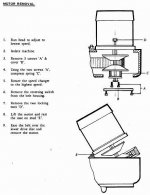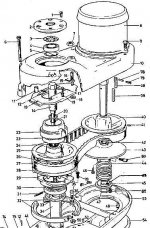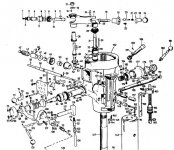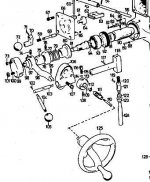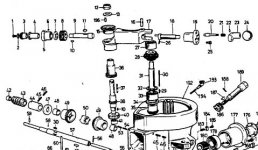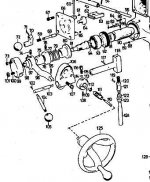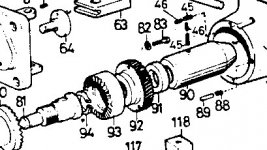npolanosky
Cast Iron
- Joined
- Apr 9, 2016
- Location
- USA, FL
Hi all,
I'm a member of an awesome makerspace called FamiLAB located in Orlando, FL. We've got some older machinery in our metal shop that needs some TLC, especially our '92 HAAS VF-1 and our Enco Knee mill. I'll start another thread for the HAAS stuff, for now this will focus on our sad little bridgeport clone.
First off, I know it's a piece of crap from across the pacific....That's part of why I'm here asking questions! If anyone would like to donate something nicer, we will happily write you a donation receipt and you can write it off on your taxes- We're a 501c3 nonprofit and we can do that. Thanks in advance Past that, it's what we've got so I'm going to work with it and hopefully get some help from the awesome folks here on PM. Be nice, I'm a newly-minted self-taught machinist a la John Saunders- Learning by the seat of my pants, youtube, and LOTS of reading, but not all of the neat tricks and basic fixes are necessarily obvious to me yet
Past that, it's what we've got so I'm going to work with it and hopefully get some help from the awesome folks here on PM. Be nice, I'm a newly-minted self-taught machinist a la John Saunders- Learning by the seat of my pants, youtube, and LOTS of reading, but not all of the neat tricks and basic fixes are necessarily obvious to me yet 
Anyway, let's get down to the problems- There are a few that I'd like some pointers on.
1.) The biggest problem we are having is that our spindle won't run over 1200RPM or so in high range, and not more than about 150 in low range. Ours has the (Bridgeport 2J?) variable speed style head as opposed to the step pulley type. When you turn on the spindle and crank the handle, it will speed up or slow down as expected, but once you hit 1200+ it audibly stops speeding up and sometimes "pulses". I'm sure it's something is the transmission and I would have pulled the head already if I knew what I was doing (Or had something to lift it safely with).
Where should I start looking for issues? Easiest way to access the bits inside? There are less access panels than I would like- To me it looks like my only way is to pull off the entire top of the head, which looks heavy to someone without a crane/hoist.
2.) Power quill feed is no worky worky. Wondering if it's related to the abovementioned mayhem in the head. Would be nice to have working, not a priority. I really don't know how to diagnose this one, but following manuals, videos, and intuition I can't get it to so much as twitch, nevermind feed properly.
3.) Feeds on the table and saddle are smooth...most of the time. Sometimes it hits a "rough" spot where all of a sudden the smooth resistance in the leadscrew gets choppy and everything starts making an awful squeaking noise. I've greased, oiled, and adjusted a few things to no avail. Worn out spots on leadscrews? Gibs need adjustment? Something else?
4.) X axis power feed worked when we got the machine, and now appears to have died. It gradually slowed down, reportedly working intermittently when given a boost to start or pressing the rapid button, then quit. Should I pull the motor and clean the brush/commutator assembly, or is it a lost cause? I have nice servomotors I could retrofit in if needed.
5.) Finally, the Z/Quill axis DRO encoder was broken. I think the glass scale is still intact, but the sensor has goop on it and some wires are detached. I'm decent at soldering, but this one could be a challenge. Anyone make (affordable) replacements, or should we continue to go without? Seems like the least critical axis to have a DRO on.
Thanks in advance- I'll probably have a lot more questions, both to figure out how to get this machine running well (Or as well as a 30 year old used, abused, import clone can!) Off to HAASland to figure out a 25 year old ATC alarm code
I'm a member of an awesome makerspace called FamiLAB located in Orlando, FL. We've got some older machinery in our metal shop that needs some TLC, especially our '92 HAAS VF-1 and our Enco Knee mill. I'll start another thread for the HAAS stuff, for now this will focus on our sad little bridgeport clone.
First off, I know it's a piece of crap from across the pacific....That's part of why I'm here asking questions! If anyone would like to donate something nicer, we will happily write you a donation receipt and you can write it off on your taxes- We're a 501c3 nonprofit and we can do that. Thanks in advance
 Past that, it's what we've got so I'm going to work with it and hopefully get some help from the awesome folks here on PM. Be nice, I'm a newly-minted self-taught machinist a la John Saunders- Learning by the seat of my pants, youtube, and LOTS of reading, but not all of the neat tricks and basic fixes are necessarily obvious to me yet
Past that, it's what we've got so I'm going to work with it and hopefully get some help from the awesome folks here on PM. Be nice, I'm a newly-minted self-taught machinist a la John Saunders- Learning by the seat of my pants, youtube, and LOTS of reading, but not all of the neat tricks and basic fixes are necessarily obvious to me yet 
Anyway, let's get down to the problems- There are a few that I'd like some pointers on.
1.) The biggest problem we are having is that our spindle won't run over 1200RPM or so in high range, and not more than about 150 in low range. Ours has the (Bridgeport 2J?) variable speed style head as opposed to the step pulley type. When you turn on the spindle and crank the handle, it will speed up or slow down as expected, but once you hit 1200+ it audibly stops speeding up and sometimes "pulses". I'm sure it's something is the transmission and I would have pulled the head already if I knew what I was doing (Or had something to lift it safely with).
Where should I start looking for issues? Easiest way to access the bits inside? There are less access panels than I would like- To me it looks like my only way is to pull off the entire top of the head, which looks heavy to someone without a crane/hoist.
2.) Power quill feed is no worky worky. Wondering if it's related to the abovementioned mayhem in the head. Would be nice to have working, not a priority. I really don't know how to diagnose this one, but following manuals, videos, and intuition I can't get it to so much as twitch, nevermind feed properly.
3.) Feeds on the table and saddle are smooth...most of the time. Sometimes it hits a "rough" spot where all of a sudden the smooth resistance in the leadscrew gets choppy and everything starts making an awful squeaking noise. I've greased, oiled, and adjusted a few things to no avail. Worn out spots on leadscrews? Gibs need adjustment? Something else?
4.) X axis power feed worked when we got the machine, and now appears to have died. It gradually slowed down, reportedly working intermittently when given a boost to start or pressing the rapid button, then quit. Should I pull the motor and clean the brush/commutator assembly, or is it a lost cause? I have nice servomotors I could retrofit in if needed.
5.) Finally, the Z/Quill axis DRO encoder was broken. I think the glass scale is still intact, but the sensor has goop on it and some wires are detached. I'm decent at soldering, but this one could be a challenge. Anyone make (affordable) replacements, or should we continue to go without? Seems like the least critical axis to have a DRO on.
Thanks in advance- I'll probably have a lot more questions, both to figure out how to get this machine running well (Or as well as a 30 year old used, abused, import clone can!) Off to HAASland to figure out a 25 year old ATC alarm code





